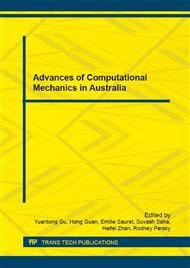p.397
p.403
p.409
p.415
p.421
p.428
p.434
p.440
p.446
Parametric Study on the Approach Problem of an Integral Abutment Bridge Subjected to Cyclic Loading due to Temperature Changes
Abstract:
Integral Abutment Bridges are widely utilized around the world because they offer a design alternative minimizing the potential construction and maintenance difficulties associated with expansion joints in other types of bridges. However, integral bridge systems also have certain issues that result from the absence of expansion joints. This is because temperature changes induce cycles of elongations and shortenings in the bridge deck which lead to rotational movements in bridge abutments against and away from the retained soil. This phenomenon may develop long term problems in terms of settlement of the backfill at the bridge approach and escalation in the lateral earth pressure acting on the bridge abutments. This paper aims to investigate the approach settlement and lateral earth pressure development in integral bridges abutments using finite element modelling of a concrete bridge abutment and the adjoining soil using the ABAQUS software. The paper presents a parametric study of the effects imposed by abutment movements on the retained soil. This study also investigates the effectiveness of using expanded polystyrene (EPS) geofoam inclusions as a remedial measure to minimize the approach settlement and lateral stress ratcheting effects in Integral Abutment Bridges.
Info:
Periodical:
Pages:
421-427
Citation:
Online since:
July 2016
Price:
Сopyright:
© 2016 Trans Tech Publications Ltd. All Rights Reserved
Share:
Citation:


